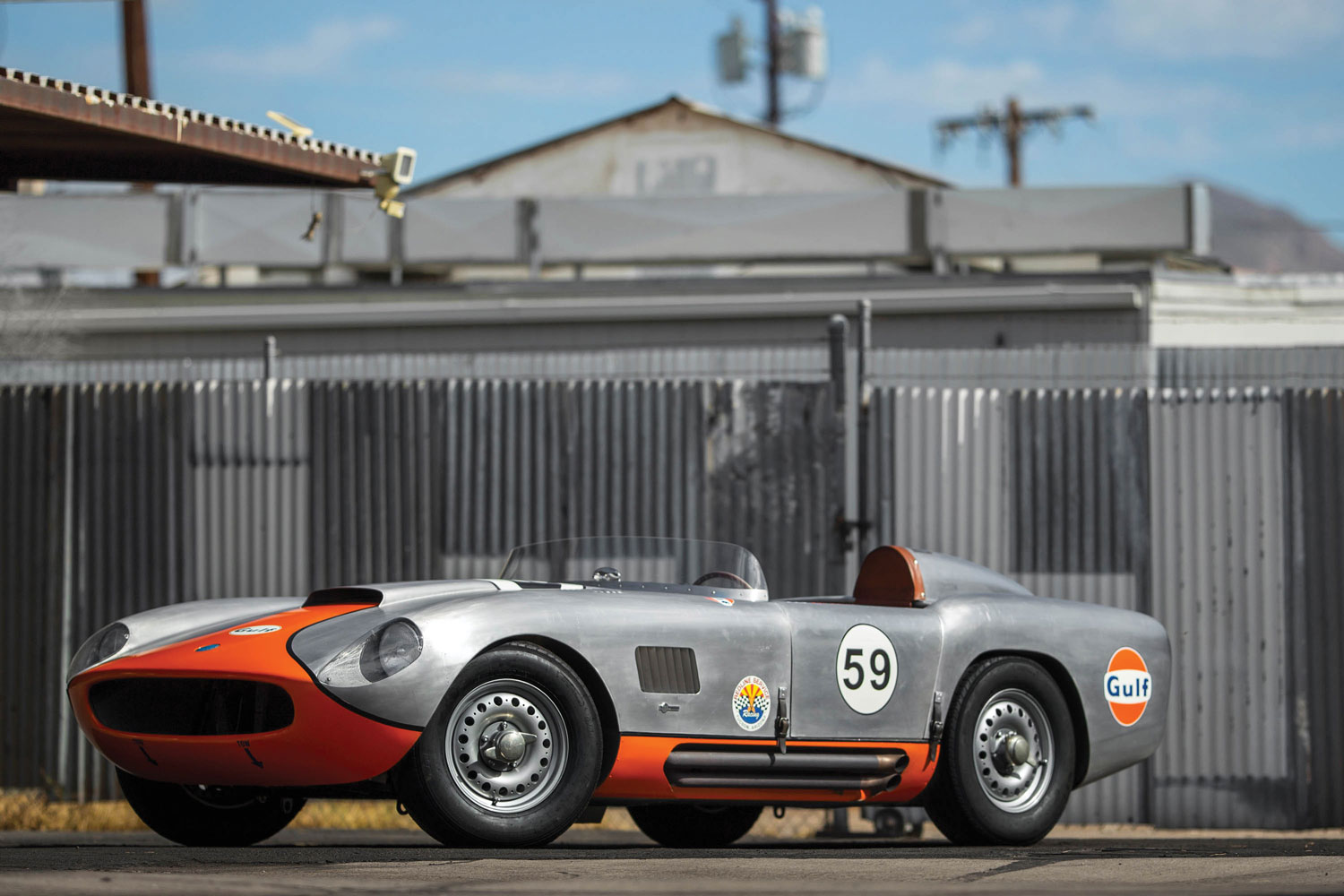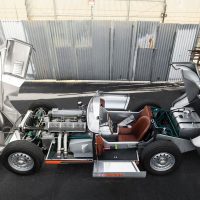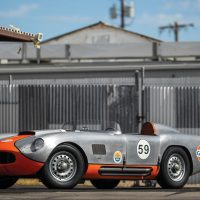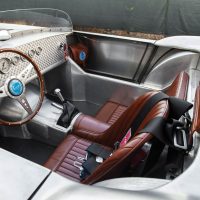- A unique post-war racing car conceived by famed race engineer John Tojeiro
- Completed to a very high standard in accordance with Tojeiro’s original vision
- Hand-formed body to original designs by Coachsmithing of Blair, WI
- 300-plus-hp, 302-cubic-inch GMC inline 6-cylinder engine; Muncie “Rock Crusher” 4-speed manual transmission
- Accompanied by history files, dyno sheets, race reports, and more
SCM Analysis
Detailing
| Vehicle: | 1959 Tojeiro California Spyder |
| Years Produced: | 2014 |
| Number Produced: | One |
| SCM Valuation: | $96,000 (this car) |
| Chassis Number Location: | N/A |
| Engine Number Location: | Beside dipstick |
| Club Info: | Sportscar Vintage Racing Association |
| Website: | http://www.svra.com |
| Alternatives: | 1959 Tojeiro Jaguar, 1959 Lister Jaguar, 1959 Devin Corvette |
This car, Lot 120, sold for $95,700, including buyer’s premium, at RM Sotheby’s Open Roads auction, held July 23–30, 2020.
Readers who had not fallen asleep during the relevant session of their Economics 101 class might recall something called the “efficient market hypothesis.” Though officially applied to the stock market, it broadly applies to things sold at public auction. In essence, it states that an efficient market will automatically factor in everything that is known, not known or suspected about a product that is offered for sale and will assign it an appropriate price.
This came to mind as I contemplated how to approach the 1959 Tojeiro California Spyder that is our topic this month. I propose that this is such a complicated situation, with issues of collectibility, originality, weapons-grade usefulness and sheer beauty all competing and contradicting each other, that the only reasonable way to figure out what it is worth is to let the market decide.
An artist at work
In the U.K. during the early post-war years, there were quite a number of small, independent automobile and racing-car constructors. Probably the best known were what could be called the “engineer constructors” like Colin Chapman of Lotus, Eric Broadley of Lola, and Brian Lister. They used their formidable engineering talents to design and build successful and enduring racing cars. The second bunch could be called the “artist constructors,” who built frequently beautiful if not particularly advanced racing cars to varying levels of success. John Tojeiro exemplifies this latter category.
Tojeiro was never successful in school and dropped out to apprentice at a garbage-truck company. During the war, he was a mechanic for the RAF and learned how lightweight airplane structures worked. After the war, he taught himself to weld and started building a racing car for himself, but somebody wanted to buy it before he could race it. So he did it again and soon he was building cars. He never saw himself as part of a serious business — he was an artist building cars because he loved doing it.
His first great success was when he copied the idea of a Ferrari barchetta for a project he built, and it became the AC Ace of 1953, which, of course, became the iconic Cobra. Tojeiro never made any money off it, having sold the design for a royalty of £5 per car, but it did establish his reputation. He continued to build specials for various customers and developed a strong, light-chassis structure with a straightforward but effective suspension that was adapted to the needs of each car.
Going in reverse
Starting in 1957, Tojeiro adapted a curious approach in that he had an artist friend named Cavendish Morton make a painting imagining a new car, then reverse-engineered the blueprints so that the car was built to look like the concept rather than stretching the body over an engineered chassis. It made for several pretty cars, particularly the Tojeiro Jaguars of 1959, but they were not particularly successful. After the front-engine Jags, Tojeiro set himself to following Cooper’s lead into mid-engine design for his client Ecurie Ecosse.
This is where the story surrounding our subject car gets started. As told, it suggests that Tojeiro started another front-engine chassis intended for an American drivetrain and a body modeled after the Ferrari 250 California Spyder. Long after it was abandoned, the chassis, along with wire bucks showing the body shape, was discovered by a Tojeiro historian. After passing through several hands, it ended up in the U.S. around 2013 (some eight years after Tojeiro died), where the car we see today was created. It was completed sometime prior to summer 2016, when it turned up as a no-sale in a Russo and Steele auction.
The question that immediately jumps to mind is: “Is this really a Tojeiro?” Documented Tojeiros from the period are worth quite a lot of money, so the issue matters. There are photos of the frame and wire bucks hanging in rafters someplace and later on a trailer, but beyond that, there appears to be little if any corroborating evidence. Tojeiro was notoriously an artist, not a businessman, so this may or may not tell us anything. But let’s be generous and assume the frame is “real.”
On Wisconsin!
The next issues then have to do with period correctness, and the story gets even more complicated. The body, built in Wisconsin around 2014, is aluminum and beautifully crafted to look distinctly late-1950s. The suspension, though, seems modern and the disc brakes are far newer than 1959. Even if the chassis was designed around a Jaguar six, Tojeiro never would have used a GMC truck engine when lighter, more-powerful V8s were easily available — his next cars used Ford V8 power. Why a Muncie “Rock Crusher” transmission — introduced in 1967 for big-block muscle cars — was used is a mystery.
That said, it is a pretty car and presents itself well as a 1959 something-or-other. In the U.S., race and tour organizers are not particularly concerned with history and will happily accept it for their 1950s grids, though it would not be acceptable in Europe. The one time it was ever on the track, the 2018 Circuit of the Americas event in Austin, TX, where it practiced and qualified but did not race, it seemed competitive in its class though well back in its racing grid. There is no reason to doubt that it would be fun to drive and it is certainly exclusive.
Market math
So how the heck do you establish a value for something like this? It had been on the market for a long time, first in 2016 at auction, then with a broker asking $300k with no buyers, now at the RM Sotheby’s sale. It certainly has desirable aspects: an attractive aluminum body (far more valuable than fiberglass), some claim to the Tojeiro name and mystique, acceptability and a good driving experience in the pre-1960 racing and touring grids, and competitive performance. But it also has major deficits in history, originality, and correctness. Who is going to want it?
Here we come back to the efficient market hypothesis: Put it out in a highly public auction, publicize it, and accept what the market is willing to tell us about its worth. A documented Tojeiro Jaguar is probably worth $400k–$600k today, but this car is not the same, or even close. The market has spoken, and the answer was clear — it was fairly purchased. ♦
(Introductory description courtesy of RM Sotheby’s.)



